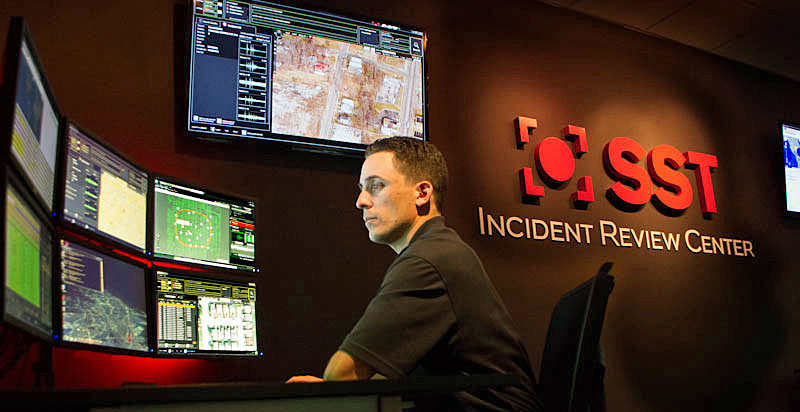U.S. cities using ShotSpotter technology, published gunfire incidents* reached a total of 74,916 for 2016, compared to 54,699 in 2015.
As part of its ShotSpotter 2016 National Gunfire Index, the report also found that the single busiest day for a city was 85 gunfire incidents, on August 14.

The highest number of gunshots in a single hour was 26 gunfire incidents on August 13, between 10:00 PM and 11:00 PM.
The ShotSpotter 2016 National Gunfire Index is based on data from a statistical sample of U.S. cities that used ShotSpotter in 2016.
The 72 cities that were analyzed had a total coverage area of 305.0 square miles, with a median coverage area of 3.1 square miles.
Key Findings:
ShotSpotter’s National Gunfire Index delivers objective urban gunfire incident data that clearly demonstrates gun violence in the U.S. is much greater than what is typically measured in terms of homicides and non-fatal shootings alone.
(ShotSpotter gunfire data enables intelligent analysis to enable, law enforcement to move from reactive to the proactive policing. ShotSpotter has been called ‘a force multiplier’ because it provides critical information for better, more timely resource allocation. Courtesy of ShotSpotter and YouTube)
Findings for 2016 include:
74,916 ShotSpotter published incidents of gunfire in the U.S. for 2016
Oct. 23 was the busiest day of gunfire for total ShotSpotter published* alerts
- with 339 gunfire incidents reported
Busiest hour of gunfire for total ShotSpotter published alerts
- 56 published gunfire incidents on August 28, 2:00AM to 3:00 AM
Busiest day of gunfire – by City
- 85 published gunfire incidents on August 14
Busiest hour of gunfire – by City
- 26 published gunfire incidents on August 13, 10:00 PM to 11:00 PM
2016 rate of gunfire per square mile in city areas covered by ShotSpotter
- Minimum = 4.3
- Median = 103.8
- Maximum = 1,214.8
Average number of rounds per reported incident – 3.8
- 3.3 rounds per incident (2015, 3.2 rounds)
- 3.6 rounds per incident (2015, 3.7 rounds)
- 3.7 rounds per incident (2015, 3.6 rounds)
- 4.3 rounds per incident (2015, 4.2 rounds)
- 6.3 rounds per incident (2015, 5.4 rounds)
Single incident with largest round of gunfire
- 65 published gunfire incidents on December 3
(New ShotSpotter technology aims to quell bloodshed in Chicago. ShotSpotter homes in on the location of gunfire while simultaneously a second computer system turns on the largest network of surveillance cameras in the country to help locate and search for suspects and victims. Courtesy of ShotSpotter and YouTube)

“With such a significant number of ShotSpotter published gunfire incidents in the past year, it’s clear to see that urban gunfire continues to be a challenge for many communities across the United States,” said ShotSpotter President and CEO Ralph A. Clark.
“But knowledge is power, and we believe the local agencies’ understanding and use of this data is critical in enabling them to partner with communities in reducing gun violence and improving the safety of residents.”
How ShotSpotter Works
ShotSpotter uses sophisticated acoustic sensors to detect, locate and alert law enforcement agencies of illegal gunfire incidents in real time.

The acoustic sensors are strategically placed in an array of 15-20 sensors per square mile in order to reliably detect and accurately triangulate gunshot activity.
Each sensor captures the precise time and location associated with boom and bang sounds (impulsive noise) that may represent a gunshot.
This data is first filtered by machine algorithms that are then further qualified by expertly-trained staff in the 24×7 Incident Review Center (IRC) at ShotSpotter, to ensure the events are in fact gunfire.

This process takes less than 45 seconds, between the actual shooting and the pushed digital alert, which includes a precise location on a map (latitude/longitude) with corresponding meta data such as the address, number of rounds fired, type of gunfire, etc. delivered to any browser-enabled device or mobile device.
Utilizing the gunfire audio clip, and tactical information, officers can approach the precise location of the gunfire incident quickly and safely to engage the shooter, interview witnesses, and collect key evidence at the crime scene.
(Learn about Shotspotter’s comprehensive gunfire alert and analysis product offering called Shotspotter Flex. Courtesy of ShotSpotter and YouTube)
ShotSpotter is the leader in gunshot detection solutions that helps law enforcement officials and security personnel identify, locate and deter gun violence.
Our public safety solution, ShotSpotter Flex, is deployed in urban, high-crime areas to help identify, locate and deter gun violence by accurately detecting and locating gunshots and sending real-time alerts to law enforcement.
Our security solutions, SST SecureCampus and ShotSpotter SiteSecure, are designed to help law enforcement and security personnel serving universities, corporate campuses and key infrastructure and transportation centers mitigate risk and enhance security by quickly notifying authorities and first responders of an active-shooter.
 The speed and accuracy of our solutions enable rapid response by enforcement and security personnel, increase the chances of apprehending the shooter, aid in evidentiary collection and serve as an overall deterrent.
The speed and accuracy of our solutions enable rapid response by enforcement and security personnel, increase the chances of apprehending the shooter, aid in evidentiary collection and serve as an overall deterrent.
ShotSpotter solutions are installed in more than 90 locations across the United States.
*published incidents = the total number of gunfire incidents detected by ShotSpotter solutions alerts that were sent to law enforcement agencies.















